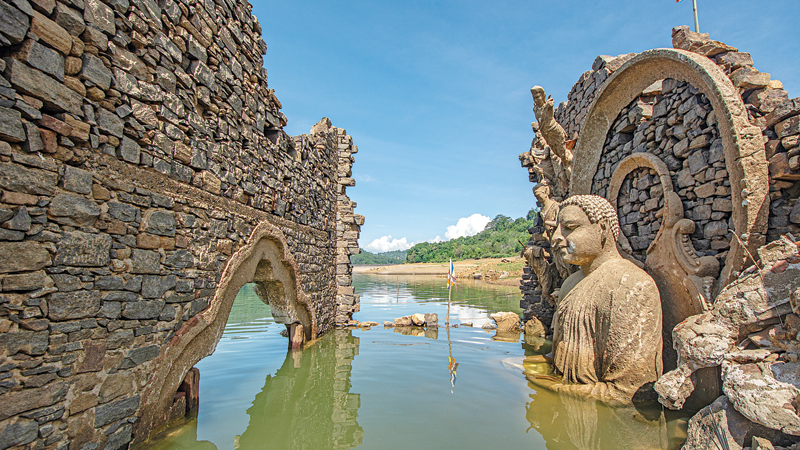 Under water when it rains and out during the drought – the majestic, ancient temple, the Kadadora Vihara, submerged in the Kotmale reservoir.
Under water when it rains and out during the drought – the majestic, ancient temple, the Kadadora Vihara, submerged in the Kotmale reservoir.
Do you know there is a glorious Buddhist temple totally submerged in a reservoir in the hill country of Sri Lanka? This ancient Buddhist temple is known as the Kadadora Vihara or Sri Priyabimbaramaya in Kotmale. Once a magnificent temple, later it was abandoned and ruined after the construction of the Kotmale Dam and reservoir in 1979 as part of the Accelerated Mahaweli Development Program.
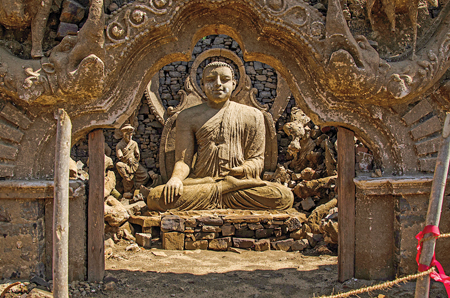
When the water level drops, a Buddha statue emerges from the bottom of the reservoir
Kadadora has a long history dating back to the time of Great King Dutugemunu. Prince Gemunu fled from the Ruhunu Rata to the Malaya Rata through the Kadadora entrance. Kotmale in the central highlands was called the Malaya Rata in ancient times. There used to be four entrances to enter Kotmale, viz, Galdora, Watadora, Niyangandora, and Kadadora. Kadadora is the only entrance that can be seen today.
By this time every year, when drought prevails in March and April in the Central Highlands, especially in the Nuwara Eliya District, the Kadadora Vihara re-surfaced from the reservoir bed of Kotmale which had been submerged in the Kotmale reservoir since 1985.
The Kadadora Vihara is a long-lost temple that has gone underwater for decades. The appearance of the temple is very rare. It remained underwater for 30 years until it reappeared in 2009, when a severe drought hit the area. It is kind of a mystery how this temple is well protected up to this level for such a long time.
During the 1900s, villagers of Kadodara built this temple on the banks of the Kotmale Oya. Construction work on the statue of Buddha was started in 1897 and it was opened in 1905. The temple is a significant historical site at Kotmale. There were many worshippers before the temple went under water in the reservoir. Definitely, nobody ever dreamed that this beautiful temple would one day be hidden under the water.
Kotmale reservoir
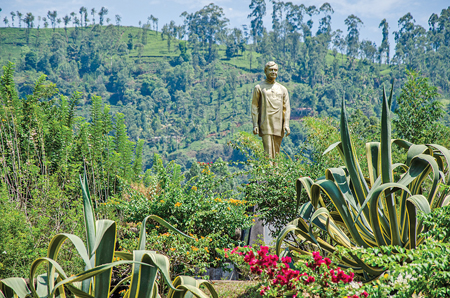
The statue of the late Minister of Land, Land Development and Mahaweli Development Gamini Dissanayake on the summit of the Kadadora hill
In 1977, the Accelerated Mahaweli Development Program was started by damming five major reservoirs. The Kotmale project was one of the five major projects proposed under this program. The construction of the Kotmale Dam gave life to the new reservoir called the Kotmale reservoir. Spread across 2,270 hectares, the Kotmale reservoir nestles between Thispane and the Kadadora hills. It spreads through the Kandy and Nuwara Eliya Districts.
The Kotmale dam site is at the historical village of Kadadora at an elevation of 2,100 feet above the sea level. The reservoir gets water from the Kotmale Oya, which is the main tributary of the Mahaweli River. Construction work on the picturesque Kotmale reservoir was completed in November 1984.
Creating this dam led to submerge 57 villages and 54 religious places in the Kotmale Valley. However, many of these temple ruins no longer exist. Miraculously, the Kadadora Vihara still remains, even though fully submerged in the water.
In each year of the recent past, I visited this magnificent temple during mid-March and early-April when the water level of the reservoir receded due to the prevailing drought. It is a surreal sight to behold. Visitors flocking to the reservoir bed of Kotmale to see the half-visible temple during the drought, wander through the crumbling, yet elegant temple with its antique architecture.
I clicked these enduring images of humanity displaying gratitude which are examples of how life goes on with nostalgic memories of one’s past, during my photographic stint at the reservoir bed of Kotmale in the recent past.
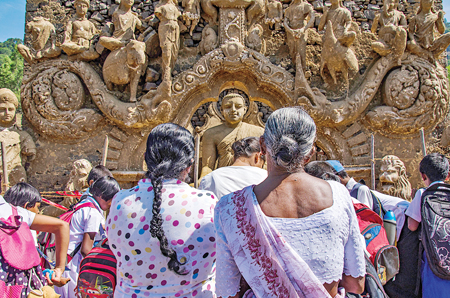
Kotmale old villagers who settle in Mahaweli lands, come to venerate the temple when it re-surfaces
Kotmale is an important historical place in the central highlands known as the Malaya Rata on the ancient Sri Lanka map where Prince Gemunu, who later became King Dutugemunu makes his mark, fleeing from the Ruhun Rata to the Malaya Rata. Later on, this historically important region became the land of the Sinhala kings and peasants.
Historical sites
Villagers built the Kadadora Vihara in the Kadadora village near Dehedukadulla on the banks of the Kotmale Oya, which is a main tributary of the Mahaweli Ganga, and one of the historical sites in Kotmale in the early part of 1900. They would not have had even an inkling in their wildest dreams that a reservoir would, about half a century later, engulf their places of worship. When the Kotmale dam, a major reservoir under the accelerated Mahaweli Development Program, was built across the Kadadora and Tispane hills in 1979, the people of the ancestral villages were relocated elsewhere. Since then, the temple structure plays the game of hide and seek – under water when it rains and out during the drought season – earning it the name ‘hiding temple.’
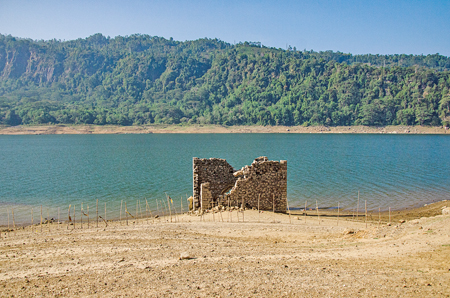
The debris of the temple gives a unique setting to the topography of the reservoir
Hundreds of ancestral villagers of Kotmale had sacrificed their properties to the reservoir. Even the ancestral land and home of the late Gamini Dissanayake, then the Land, Land Development and Mahaweli Development Minister had been submerged in the Kotmale reservoir. The late Minister Dissanayake was born as the eldest son of a family of seven children, to Andrew Dissanayake and Welagedera Samaratunge Kumarihamy of Kotmale. Till the age of four he grew up in the idyllic surroundings of the Kotmale valley nestling between the terraced paddy fields and the Mahaweli Ganga, later to be linked with his own political career.
More than 50 temples were submerged when the Kotmale reservoir was constructed damming Tispane and Kadadora hills and a massive chaitya known as the Mahaweli Maha Seya constructed on the summit of the Kadadora hill overlooking the Kotmale reservoir to symbolise the submerged religious monuments in the area.
When it surfaces, visitors come in their hundreds, and offer flowers and get blessings. It has now become a popular backdrop for selfies. In March and April, when the water level is low and the temple is visible, villagers gather around gazing at the majestic remains of the statue of the Buddha, harking back to a time when they gathered in the temple premises decades ago.



